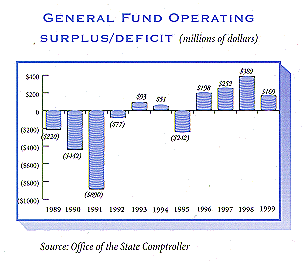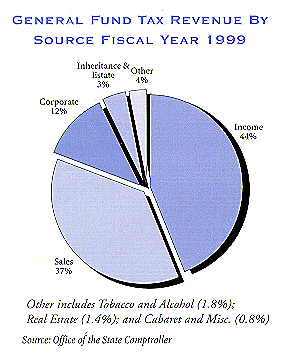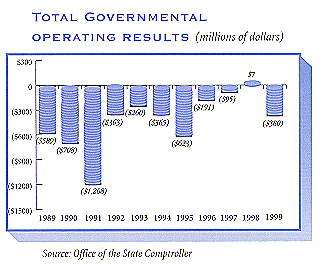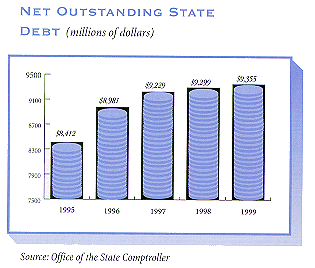

 |
Reporting
Format The financial data presented below was developed in accordance with Generally Accepted Accounting Principles (GAAP). GAAP is the standard for financial reporting in both the public and private sectors. To date, Connecticut has not adopted GAAP for budgetary appropriation and control purposes. The state uses a modified cash accounting system as its legal budget basis. However, due to volatility in the timing of payments and posting of revenues, the modified cash system can distort the state's true financial picture. GAAP reporting eliminates the distortions and, therefore, provides a more accurate financial overview of the state's fiscal position. |
 |
Fiscal Year 1999 General Fund Performance - Operating Results for One State Fund in a Single Fiscal Year | |
| The General Fund is the state's largest single operating fund. Over 85 percent of all state operating expenses are accounted for within the General Fund. | ||
| In Fiscal Year 1999, the state recorded a General Fund surplus of $169 million with revenues totaling $11.457 billion and expenditures of $11.288 billion. This was the fourth consecutive year in which the General Fund recorded a surplus. The surplus is equal to 1.5 percent of General Fund expenditures. | ||
| Since the introduction of the income tax in 1991, the state's cumulative General Fund surpluses totaled $833 million. | ||
| The sum of $30,473,982 was placed in the state's rainy day fund in Fiscal Year 1999 bringing the rainy day fund balance to $529,077,535. In addition, $41,285,204 was made available to retire outstanding bonded debt. | ||
| Despite the continuation of phased-in tax reductions that cut General Fund receipts by approximately $300 million in Fiscal Year 1999, strong national and state economic growth propelled revenues forward. The extraordinary economic growth largely explains the state's positive fiscal position. | ||
| On a budgetary basis General Fund revenues closed Fiscal Year 1999 $624.4 million higher than initial estimates. However, most of the excess revenue was appropriated and, therefore, did not become surplus. |
The following financial information is presented in a table format. Follow this link for a plain text version of this information.
| STATE OF CONNECTICUT | |||||||
|---|---|---|---|---|---|---|---|
| General Fund Revenues | |||||||
| (millions of dollars) | |||||||
| Annual 5 Year |
|||||||
| FY 1994 | FY 1995 | FY 1996 | FY 1997 | FY 1998 | FY 1999 | Growth Rate |
|
| TAXES | |||||||
| Income | 2,270 | 2,306 | 2,606 | 2,799 | 3,197 | 3,368 | 8.2% |
| Sales | 2,167 | 2,355 | 2,444 | 2,598 | 2,759 | 2,922 | 6.2% |
| Corporation | 609 | 604 | 629 | 534 | 506 | 461 | -5.4% |
| Utilities | 187 | 185 | 192 | 179 | 170 | 168 | -2.1% |
| Inheritance & Estate | 197 | 183 | 231 | 208 | 259 | 216 | 1.9% |
| Insurance Companies | 169 | 171 | 167 | 189 | 183 | 180 | 1.3% |
| Tobacco | 120 | 130 | 125 | 126 | 126 | 122 | 0.3% |
| 276 | 416 | 437 | 421 | 385 | 362 | 5.6% | |
| Total | $5,995 | $6,350 | $6,831 | $7,054 | $7,585 | $7,799 | 5.4% |
| OTHER REVENUE | |||||||
| Federal Grants | 2,480 | 2,562 | 2,644 | 2,585 | 2,646 | 2,709 | 1.8% |
| Casino Payments | 113 | 136 | 149 | 204 | 258 | 288 | 20.6% |
| Lottery | 218 | 250 | 262 | 252 | 267 | 274 | 4.7% |
| Miscellaneous | 405 | 346 | 333 | 370 | 356 | 387 | -0.9% |
| TOTAL | $9,211 | $9,644 | $10,219 | $10,465 | $11,112 | $11,457 | 4.5% |
| Source: Office of the State Comptroller | |||||||
General Fund Revenues: Taxes and Other Revenues
| In Fiscal Year 1999, total General Fund revenue increased 3.1 percent over the prior year. The income tax and the sales tax, which combine to produce 55 percent of the total revenue, increased by 5.3 percent and 5.9 percent respectively from the previous year. | |
| Taxes accounted for 68 percent of all General Fund revenue. Federal payments to the state contribute 24 percent to total revenue. The remaining 8 percent of General Fund revenues consist of gaming payments, interest earnings, licenses, fees, investment earnings, fines and forfeitures, charges and other miscellaneous payments. | |
| Of the major General Fund revenue sources, the income tax has experienced the highest rate of increase with five-year average annual growth of 8.2 percent. Strong employment gains coupled with booming financial markets explain the increase. |
The following financial information is presented in a table format. Follow this link for a plain text version of this information.
| STATE OF CONNECTICUT | |||||||
| General Fund Expenditures | |||||||
| (Millions of dollars) | |||||||
| Annual 5 Year |
|||||||
|---|---|---|---|---|---|---|---|
| FY 94 | FY 95 | FY 96 | FY 97 | FY 98 | FY 99 | Growth Rate | |
| Legislative | 46 | 47 | 48 | 52 | 55 | 65 | 7.2% |
| General Government | 495 | 510 | 550 | 554 | 600 | 845 | 11.3% |
| Regulation & Protection | 105 | 103 | 105 | 116 | 121 | 215 | 15.4% |
| Conservation and Development | 57 | 64 | 65 | 80 | 81 | 92 | 10.0% |
| Health & Hospitals | 753 | 781 | 819 | 893 | 952 | 1,050 | 6.9% |
| Human Services (1) | 2,899 | 3,378 | 3,439 | 3,496 | 3,541 | 3,475 | 3.7% |
| Education | 1,747 | 1,725 | 1,820 | 1,805 | 1,879 | 1,952 | 2.2% |
| Higher Education | 364 | 450 | 442 | 482 | 517 | 588 | 10.1% |
| Corrections | 727 | 789 | 839 | 943 | 932 | 1,027 | 7.2% |
| Judicial | 224 | 234 | 265 | 290 | 311 | 352 | 9.5% |
| Federal & Other Grants (2) | 971 | 871 | 808 | 607 | 682 | 551 | -10.7% |
| Debt Service | 682 | 845 | 729 | 805 | 864 | 973 | 7.4% |
| Other | 90 | 89 | 92 | 90 | 188 | 103 | 2.7% |
| TOTAL | 9,160 | 9,886 | 10,021 | 10,213 | 10,723 | 11,288 | 4.3% |
| Source: Office of the State Comptroller | |||||||
| (1) Note: Human Services includes Medicaid expenditures. | |||||||
| (2) The decrease in Federal & Other Grants is largely due to an accounting correction in the treatment of disproportionate share payments not a reduction in federal money. | |||||||
General Fund Expenditures:
| In Fiscal Year 1999, General Fund spending increased by 5.3 percent, almost double the general rate of inflation. This approximates the historically high spending levels of the early part of the last decade. It is important to compare spending increases to the general inflation rate because inflation is a factor employers use to determine wage increases. Therefore, inflation provides one indicator of the taxpayer's ability to fund increases in government spending. | |
| For the second straight year the state's constitutional cap on spending was exceeded. The additional appropriations required a declaration of extraordinary circumstances by the Governor. The cap was exceeded by $525.7 million in Fiscal Year 1999, and by $194.1 million in Fiscal Year 1998. | |
| The Fiscal Year 1999 expenditure growth rate is a full percentage point higher than average annual growth over the past five years. The spending trend is moving in the wrong direction. It is doubtful that long-term revenues will be sufficient to support this trend toward higher spending. |
Beyond The General Fund - Total Governmental Operations
The state undertakes various activities that do not appear in the General Fund. These activities include transportation and housing programs, grants to municipalities, loan programs, and other services. When these activities are combined with those of the General Fund, a true picture of state governmental operations emerges.
| Combined governmental operating results for Fiscal Year 1999 show a deficit of $380 million. The deficit arises from grant and loan payments that are not supported by current revenues. Therefore, the state must borrow to cover the shortfall. | |
| Operating deficits of $483 million were incurred in the Grants and Loan Programs and in the Housing Programs. In Fiscal Year 1998, the General Fund surplus was large enough to more than offset the persistent shortfalls in other operating areas. The Fiscal Year 1999 surplus was not sufficient to cover the other operating deficits. |
| Cumulative Financial Position of the State -The Balance Sheet | ||
| In evaluating the state's fiscal health, there is a tendency to focus exclusively on a single year of state operations. This approach fails to provide an overall, long-term view of the state's financial position. The balance sheet provides this overall perspective. The balance sheet shows state assets, liabilities, and fund balances at the close of each fiscal year. | 
|
|
| At the end of Fiscal Year 1999, the General Fund balance sheet displayed a cumulative GAAP deficit of $602.7 million. While this is a decline from last year, it still represents an increase of almost 30 percent from five years ago. In addition, the decline is temporary since a large portion is attributable to the one-time payment of accumulated payroll liabilities. These payroll liabilities will begin to rise again in Fiscal Year 2000 and the GAAP deficit will again trend upward. | ||
| The main reason for the balance sheet deficit is the state's continued reliance on a flawed system of budgeting. The state's modified cash accounting system that is used for budgeting purposes allows some revenues to be counted before they are earned while some expenditures are not counted for months after the liability arises. When GAAP corrections are made a deficit results. | ||
| The GAAP deficit is an important number because those who invest in Connecticut's bonds and notes review it. If the state's GAAP deficit is perceived to present an investment risk, the interest payments on the debt will rise costing state taxpayers millions more. | ||
| The way to improve the state's balance sheet position is clear: adopt GAAP as the legal basis for state budgeting. |

|
DEBT POSITION | |
| Connecticut continues to lead the nation in state tax supported debt per capita. Bonded debt per capita has more than doubled over the past decade, growing to $2,857 by the end of Fiscal Year 1999. | ||
| In Fiscal Year 1999, the state added an additional $56 million to its net outstanding bonded debt total. To see growing debt in these prosperous times is of great concern. | ||
| In Fiscal Year 1999, the state issued $1.008 billion in new debt. Of this total $454 million was for infrastructure or other assets benefiting future generations of taxpayers. The remaining $554 million was used to fund ongoing state operating expenses. Bonding used to provide tangible benefits to future generations is justifiable; bonding for ongoing programs that could be considered part of normal government operating expenses is a more dubious practice. | ||
| Large amounts of debt require high annual debt service (principal and interest) payments. In Fiscal Year 1999, debt service payments consumed about ten cents of every dollar spent by the state. | ||
| Debt service is a fixed cost that cannot be quickly adjusted when state revenue growth slows and budget deficits are projected. In difficult economic times a high debt load can cripple a state's ability to respond effectively to the fiscal challenges it faces. | ||
| Bonded debt represents about half of the state's total long-term obligations. In Fiscal Year 1999, state long-term debt obligations totaled $17.204 billion. Bond debt and unfunded pension liabilities account for 96 percent of the total long-term obligations. Much of the increase in the pension liabilities is attributable to an early retirement program. |
The following financial information is presented in a table format. Follow this link for a plain text version of this information.
| Trends in Long-Term Debt Obligations | |||||
| (millions of dollars) | |||||
| Category | FY 1995 | FY 1996 | FY 1997 | FY 1998 | FY 1999 |
|---|---|---|---|---|---|
| Bonds | 8,412 | 8,981 | 9,229 | 9,299 | 9,355 |
| Pension Liabilities | 6,090 | 6,334 | 6,597 | 6,761 | 7,242 |
| Workers' Comp. | 287 | 268 | 283 | 279 | 280 |
| Compensated Absences | 257 | 262 | 260 | 264 | 275 |
| Capital Leases | 56 | 54 | 49 | 48 | 52 |
| TOTAL | 15,102 | 15,899 | 16,418 | 16,651 | 17,204 |
| Source: Office of the State Comptroller | |||||